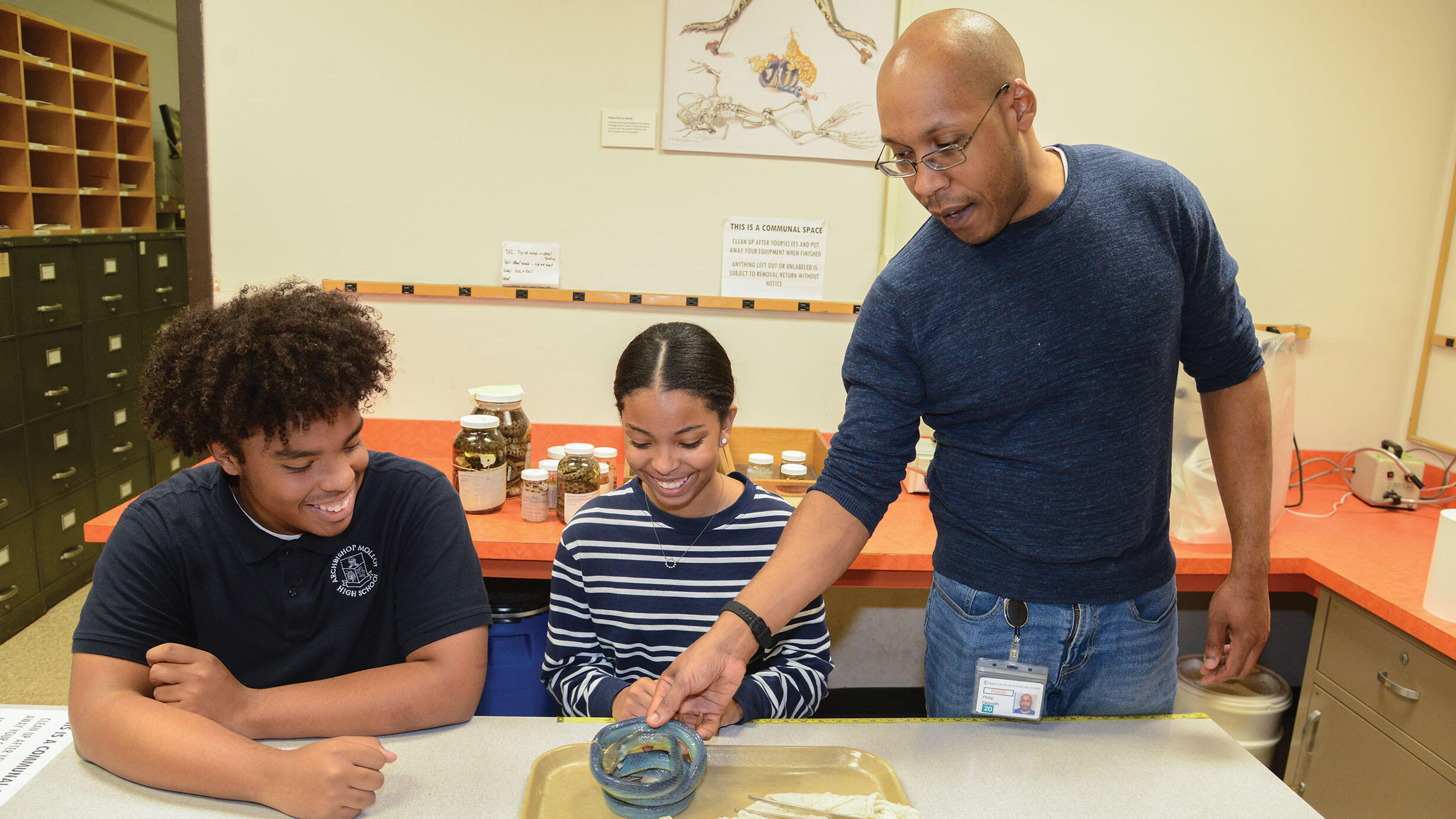 SRMP students Johanna and Xavier shown working with postdoctoral researcher Phillip “Skip” Skipwith in January to analyze snake specimens from the Museum’s herpetology collection.
SRMP students Johanna and Xavier shown working with postdoctoral researcher Phillip “Skip” Skipwith in January to analyze snake specimens from the Museum’s herpetology collection.R. Mickens/© AMNH
When the Museum closed to the public in March to maintain health and safety during the COVID-19 pandemic, several education programs continued remotely, and this story profiles two of the students.
On most Tuesdays and Wednesdays earlier this year, Johanna, 16, and Xavier, 17, could be found in a lab on the Museum's fifth floor. The two teens have been working with Phillip "Skip" Skipwith, a postdoctoral researcher in the Department of Herpetology, as part of the Museum’s Science and Research Mentoring Program (SRMP), which matches high school students with Museum scientists for a year-long research project. They have been analyzing Malagasy gemsnakes, exploring questions that have fascinated their mentor for years.
“There is evidence that under the same environmental and selective pressures different snakes will develop a similar overall appearance, or phenotype,” says Skipwith. “It’s called convergent evolution. While the Malagasy gemsnakes have generated an astounding degree of ecological diversity, they’ve managed to replicate phenotypes seen elsewhere in unrelated snakes.”
One day last winter, hoping to help prove that point, Johanna and Xavier sat looking intently at side-by-side monitors in the Museum’s lab as they rotated high-resolution micro CT scans of snake skulls, trying to isolate a specific bone structure essential to eating called the pterygoid.
“That’s a beautiful skull!” said Xavier, pointing to his screen. He explained that too often details are hard to see, but the Madagascarophis skull on view is clearly defined. Not so for Johanna, who noted that on her screen, the image of Langaha madagascariensis—known as Pinocchio or leaf-nosed snake because of its elongated snout—had an odd nodule obscuring the piece of bone she was looking to identify. “I’ll have to edit it out,” she said.
R. Mickens/© AMNH
Like all SRMP students—there are 58 in the program this year—Johanna and Xavier completed one year of after-school preparatory courses at the Museum before embarking on their work with Skipwith. While they are working with him to analyze snake specimens from the herpetology collection, their peers are working with mentors from across the Museum’s scientific departments on subjects ranging from spider venom to brown dwarfs. Each student has an opportunity to learn cutting-edge techniques and use state-of-the-art tools, in addition to attending sessions about science professions, practicing presentation skills, and participating in college readiness activities. Students also earn a stipend after completing program requirements, to help make it possible for youth who may be forgoing a part-time job participate.
“SRMP is a chance for high school students to do real science, with real scientists,” says Maria Strangas, manager of the Science Research Mentoring Program. “They get a sense of what it’s like to do research and along the way they build skills that prepare them for any career, whether they choose to go into science or not.”
Johanna and Xavier, for example, are analyzing morphological data, making comparisons with snakes in other groups, reading scientific articles, and blogging about their work. On Saturday, June 20, they will present their work at the annual SRMP Research Colloquium, which will be held online this year.
Based on the success of the SRMP model, the Museum has helped to launch a city-wide consortium of similar programs. The NYC Science Research Mentoring Consortium now consists of 23 institutional partners at 24 sites across New York City that are providing mentored research experiences to about 500 youth annually.
In the meantime, their work with Skipwith has already opened new and exciting directions. Johanna, a junior at Manhattan Center for Science and Mathematics High School, is weighing her dream of becoming a pediatrician against a newfound passion for lab research.
R. Mickens/© AMNH
Xavier, a senior at Archbishop Molloy High School in Queens, hasn’t narrowed his options yet, recalling a scientist who told him her career path was wildly different from what he thought it might be at Xavier’s age. For now, Xavier says, “I want to take advantage of all the skills I can learn.”
A version of this story appears in the Spring issue of the Member Magazine Rotunda.